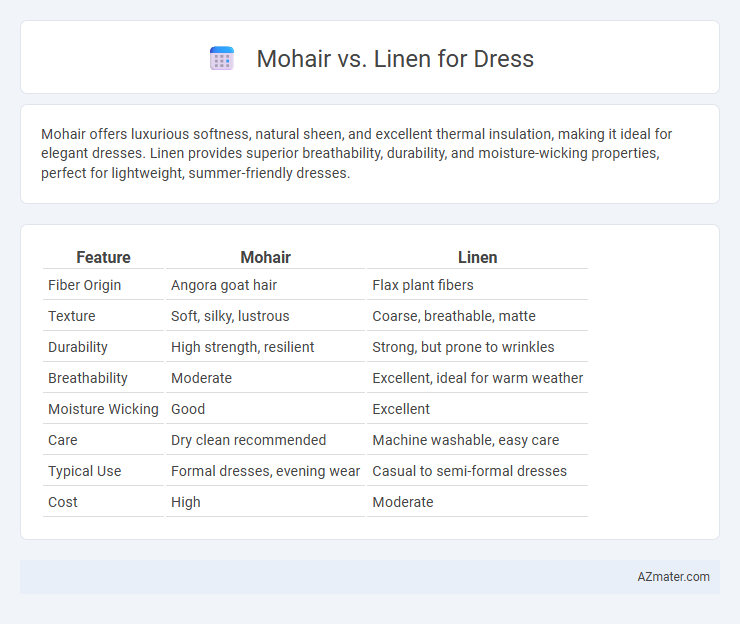Mohair offers luxurious softness, natural sheen, and excellent thermal insulation, making it ideal for elegant dresses. Linen provides superior breathability, durability, and moisture-wicking properties, perfect for lightweight, summer-friendly dresses.
Table of Comparison
| Feature | Mohair | Linen |
|---|---|---|
| Fiber Origin | Angora goat hair | Flax plant fibers |
| Texture | Soft, silky, lustrous | Coarse, breathable, matte |
| Durability | High strength, resilient | Strong, but prone to wrinkles |
| Breathability | Moderate | Excellent, ideal for warm weather |
| Moisture Wicking | Good | Excellent |
| Care | Dry clean recommended | Machine washable, easy care |
| Typical Use | Formal dresses, evening wear | Casual to semi-formal dresses |
| Cost | High | Moderate |
Introduction to Mohair and Linen Fabrics
Mohair, derived from the Angora goat, is renowned for its lustrous sheen, durability, and lightweight warmth, making it a popular choice for luxurious dress fabrics. Linen, made from flax fibers, offers excellent breathability, moisture-wicking properties, and a natural texture that suits summer dresses and formal wear. Both fabrics provide distinct tactile experiences and aesthetic qualities essential for tailoring stylish, comfortable dresses.
Origins and Production Methods
Mohair originates from the Angora goat found primarily in Turkey, South Africa, and the United States, with fibers harvested through shearing every six months. Linen is derived from the flax plant, cultivated mainly in Europe, particularly Belgium and France, where the fibers are extracted by retting, drying, and then spinning into threads. Mohair production emphasizes animal husbandry and fiber clipping, while linen relies on agricultural cultivation and a labor-intensive retting process for fiber separation.
Texture and Appearance Comparison
Mohair offers a smooth, lustrous texture with a natural sheen that enhances the elegance of dresses, creating a soft yet durable fabric ideal for formal wear. Linen is characterized by its crisp, slightly rough texture and matte finish, providing a breathable and casual look perfect for warm-weather attire. The contrast between mohair's silky surface and linen's coarse weave influences the dress's overall appearance, balancing luxury with comfort depending on the occasion.
Durability and Longevity
Mohair offers exceptional durability due to its strong and resilient fibers, making it resistant to wear and tear for long-lasting dresses. Linen, while lightweight and breathable, tends to weaken with frequent washing and prolonged exposure to sunlight, reducing its lifespan compared to mohair. Dresses crafted from mohair maintain their structural integrity and appearance over time, providing superior longevity compared to linen alternatives.
Comfort and Breathability
Mohair fibers offer exceptional softness and insulating properties, making dresses comfortable for cooler weather but potentially less breathable in heat. Linen is highly breathable and moisture-wicking, ideal for warm climates due to its natural ability to keep the skin cool and dry. Choosing between mohair and linen depends on the dress's intended seasonal use, with linen favored for summer comfort and mohair suited for cooler temperatures.
Suitability for Different Dress Styles
Mohair offers a luxurious sheen and excellent drape, making it ideal for formal suits and evening dresses that require structure and elegance. Linen provides breathability and a natural texture, best suited for casual or summer attire where comfort and a relaxed fit are prioritized. Both fabrics serve distinct dress styles, with mohair excelling in polished, tailored looks and linen favoring laid-back, breathable designs.
Maintenance and Care Requirements
Mohair dresses require gentle hand washing or dry cleaning to maintain their soft texture and prevent fiber damage, while avoiding direct heat and sunlight during drying extends their lifespan. Linen dresses are more durable and can withstand machine washing on a gentle cycle but need prompt air drying to avoid mildew and wrinkles, with occasional ironing recommended to retain a crisp appearance. Both fabrics benefit from storage in a cool, dry place, with mohair demanding more delicate handling due to its susceptibility to stretching and pilling.
Cost and Availability
Mohair fabric is generally more expensive than linen due to its production from the hair of Angora goats, which requires intensive care and limited supply. Linen is widely available and more affordable, as it is made from flax fibers that are cultivated in many regions globally. The cost difference and linen's broader availability make it a practical choice for budget-conscious dressmakers compared to the luxury and exclusivity associated with mohair.
Environmental Impact
Mohair, derived from Angora goats, has a renewable but resource-intensive production process, involving significant water use and land impact, though it is biodegradable and durable. Linen, made from flax plants, boasts a lower environmental footprint due to minimal water and pesticide requirements, and it is fully biodegradable with strong carbon sequestration potential. Choosing linen over mohair for dresses supports sustainable fashion by reducing water consumption and chemical use while promoting renewable fiber cultivation.
Choosing the Best Fabric for Your Dress
Mohair offers a luxurious sheen and exceptional durability, making it an excellent choice for elegant dresses that require a smooth, lustrous finish. Linen provides breathability and natural texture, ideal for casual or summer dresses with a lightweight, breathable feel. Consider mohair for formal occasions and linen for comfort and ease in warm weather when choosing the best fabric for your dress.

Infographic: Mohair vs Linen for Dress
 azmater.com
azmater.com